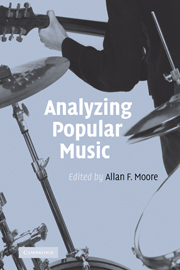Book contents
- Frontmatter
- Contents
- Acknowledgement
- Contributors
- 1 Introduction
- 2 Popular music analysis: ten apothegms and four instances
- 3 From lyric to anti-lyric: analyzing the words in pop song
- 4 The sound is ‘out there’: score, sound design and exoticism in The X-Files
- 5 Feel the beat come down: house music as rhetoric
- 6 The determining role of performance in the articulation of meaning: the case of ‘Try a Little Tenderness’
- 7 Marxist music analysis without Adorno: popular music and urban geography
- 8 Jethro Tull and the case for modernism in mass culture
- 9 Pangs of history in late 1970s new-wave rock
- 10 Is anybody listening?
- 11 Talk and text: popular music and ethnomusicology
- Bibliography
- Discography
- Film/Videography
- Index
4 - The sound is ‘out there’: score, sound design and exoticism in The X-Files
Published online by Cambridge University Press: 22 September 2009
- Frontmatter
- Contents
- Acknowledgement
- Contributors
- 1 Introduction
- 2 Popular music analysis: ten apothegms and four instances
- 3 From lyric to anti-lyric: analyzing the words in pop song
- 4 The sound is ‘out there’: score, sound design and exoticism in The X-Files
- 5 Feel the beat come down: house music as rhetoric
- 6 The determining role of performance in the articulation of meaning: the case of ‘Try a Little Tenderness’
- 7 Marxist music analysis without Adorno: popular music and urban geography
- 8 Jethro Tull and the case for modernism in mass culture
- 9 Pangs of history in late 1970s new-wave rock
- 10 Is anybody listening?
- 11 Talk and text: popular music and ethnomusicology
- Bibliography
- Discography
- Film/Videography
- Index
Summary
Introduction
While scoring for films is a subject which has finally, belatedly, been drawing scholarly attention, the television sound-world is still largely uncharted territory. The assumption is made, implicitly, that techniques are merely transferred from the big screen to the small. Although it is now widely accepted that visual codes are not fully transferable from one medium to the other – television has roots in theatre and radio, as well as in film – the study of sound, once again, lags so far behind that of image in television that it is practically non-existent.
Just as shot composition, editing, lighting, special effects, and acting are different in television and films – for various historical and technical reasons, television is thought of in terms of limitations vis-à-vis film (smaller screen, smaller budgets, shorter attention span) – sound is also different. Speakers are small and limited in reproductive range; stereo is a recent development and still dependent upon relatively poor quality and little or no practical separation, unless viewers invest in exterior speakers for their television sets. Therefore, frequency and dynamic range are restricted, and clarity of musical voice-leading is compromised.
Film and television are different. Television as it exists in most parts of the world is a commercial enterprise, a long flow of advertisements for products interrupted by a schedule of entertainments which in effect serve as inducements for the real commodity – the consumers who are sold to the advertisers on the basis of the shows they watch.
- Type
- Chapter
- Information
- Analyzing Popular Music , pp. 60 - 79Publisher: Cambridge University PressPrint publication year: 2003
- 2
- Cited by



